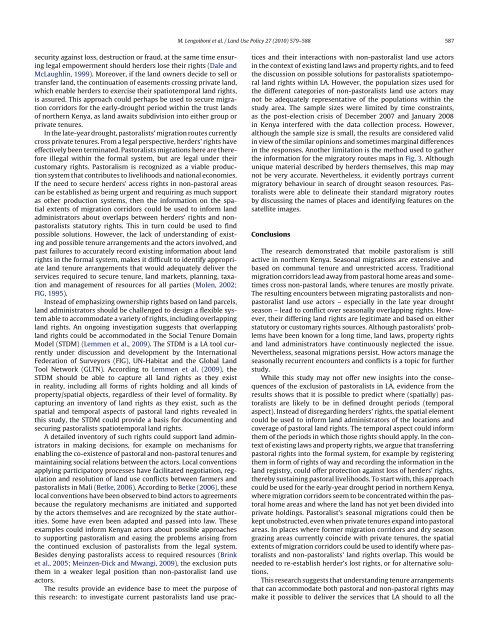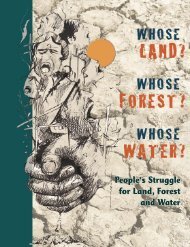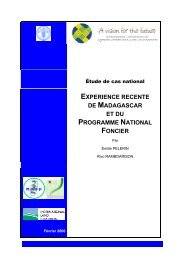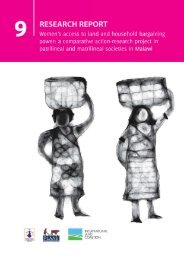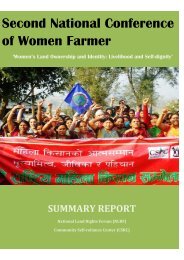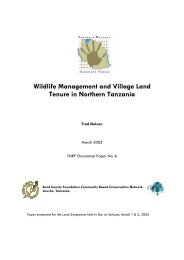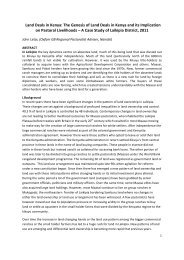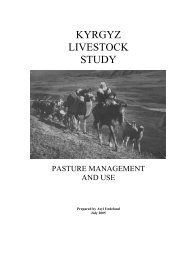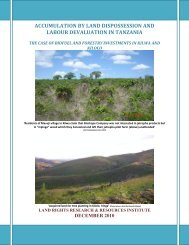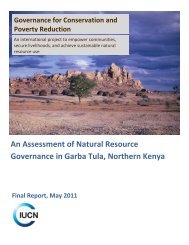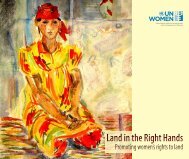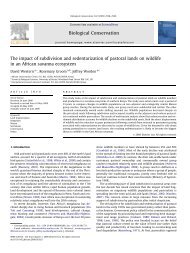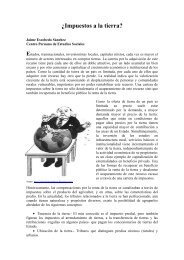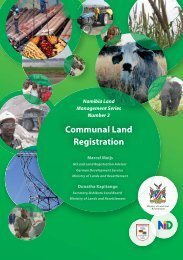Land Use Policy Pastoralism within land administration ... - Land Portal
Land Use Policy Pastoralism within land administration ... - Land Portal
Land Use Policy Pastoralism within land administration ... - Land Portal
Create successful ePaper yourself
Turn your PDF publications into a flip-book with our unique Google optimized e-Paper software.
security against loss, destruction or fraud, at the same time ensuring<br />
legal empowerment should herders lose their rights (Dale and<br />
McLaughlin, 1999). Moreover, if the <strong>land</strong> owners decide to sell or<br />
transfer <strong>land</strong>, the continuation of easements crossing private <strong>land</strong>,<br />
which enable herders to exercise their spatiotemporal <strong>land</strong> rights,<br />
is assured. This approach could perhaps be used to secure migration<br />
corridors for the early-drought period <strong>within</strong> the trust <strong>land</strong>s<br />
of northern Kenya, as <strong>land</strong> awaits subdivision into either group or<br />
private tenures.<br />
In the late-year drought, pastoralists’ migration routes currently<br />
cross private tenures. From a legal perspective, herders’ rights have<br />
effectively been terminated. Pastoralists migrations here are therefore<br />
illegal <strong>within</strong> the formal system, but are legal under their<br />
customary rights. <strong>Pastoralism</strong> is recognized as a viable production<br />
system that contributes to livelihoods and national economies.<br />
If the need to secure herders’ access rights in non-pastoral areas<br />
can be established as being urgent and requiring as much support<br />
as other production systems, then the information on the spatial<br />
extents of migration corridors could be used to inform <strong>land</strong><br />
administrators about overlaps between herders’ rights and nonpastoralists<br />
statutory rights. This in turn could be used to find<br />
possible solutions. However, the lack of understanding of existing<br />
and possible tenure arrangements and the actors involved, and<br />
past failures to accurately record existing information about <strong>land</strong><br />
rights in the formal system, makes it difficult to identify appropriate<br />
<strong>land</strong> tenure arrangements that would adequately deliver the<br />
services required to secure tenure, <strong>land</strong> markets, planning, taxation<br />
and management of resources for all parties (Molen, 2002;<br />
FIG, 1995).<br />
Instead of emphasizing ownership rights based on <strong>land</strong> parcels,<br />
<strong>land</strong> administrators should be challenged to design a flexible system<br />
able to accommodate a variety of rights, including overlapping<br />
<strong>land</strong> rights. An ongoing investigation suggests that overlapping<br />
<strong>land</strong> rights could be accommodated in the Social Tenure Domain<br />
Model (STDM) (Lemmen et al., 2009). The STDM is a LA tool currently<br />
under discussion and development by the International<br />
Federation of Surveyors (FIG), UN-Habitat and the Global <strong>Land</strong><br />
Tool Network (GLTN). According to Lemmen et al. (2009), the<br />
STDM should be able to capture all <strong>land</strong> rights as they exist<br />
in reality, including all forms of rights holding and all kinds of<br />
property/spatial objects, regardless of their level of formality. By<br />
capturing an inventory of <strong>land</strong> rights as they exist, such as the<br />
spatial and temporal aspects of pastoral <strong>land</strong> rights revealed in<br />
this study, the STDM could provide a basis for documenting and<br />
securing pastoralists spatiotemporal <strong>land</strong> rights.<br />
A detailed inventory of such rights could support <strong>land</strong> administrators<br />
in making decisions, for example on mechanisms for<br />
enabling the co-existence of pastoral and non-pastoral tenures and<br />
maintaining social relations between the actors. Local conventions<br />
applying participatory processes have facilitated negotiation, regulation<br />
and resolution of <strong>land</strong> use conflicts between farmers and<br />
pastoralists in Mali (Betke, 2006). According to Betke (2006), these<br />
local conventions have been observed to bind actors to agreements<br />
because the regulatory mechanisms are initiated and supported<br />
by the actors themselves and are recognized by the state authorities.<br />
Some have even been adapted and passed into law. These<br />
examples could inform Kenyan actors about possible approaches<br />
to supporting pastoralism and easing the problems arising from<br />
the continued exclusion of pastoralists from the legal system.<br />
Besides denying pastoralists access to required resources (Brink<br />
et al., 2005; Meinzen-Dick and Mwangi, 2009), the exclusion puts<br />
them in a weaker legal position than non-pastoralist <strong>land</strong> use<br />
actors.<br />
The results provide an evidence base to meet the purpose of<br />
this research: to investigate current pastoralists <strong>land</strong> use prac-<br />
M. Lengoiboni et al. / <strong>Land</strong> <strong>Use</strong> <strong>Policy</strong> 27 (2010) 579–588 587<br />
tices and their interactions with non-pastoralist <strong>land</strong> use actors<br />
in the context of existing <strong>land</strong> laws and property rights, and to feed<br />
the discussion on possible solutions for pastoralists spatiotemporal<br />
<strong>land</strong> rights <strong>within</strong> LA. However, the population sizes used for<br />
the different categories of non-pastoralists <strong>land</strong> use actors may<br />
not be adequately representative of the populations <strong>within</strong> the<br />
study area. The sample sizes were limited by time constraints,<br />
as the post-election crisis of December 2007 and January 2008<br />
in Kenya interfered with the data collection process. However,<br />
although the sample size is small, the results are considered valid<br />
in view of the similar opinions and sometimes marginal differences<br />
in the responses. Another limitation is the method used to gather<br />
the information for the migratory routes maps in Fig. 3. Although<br />
unique material described by herders themselves, this map may<br />
not be very accurate. Nevertheless, it evidently portrays current<br />
migratory behaviour in search of drought season resources. Pastoralists<br />
were able to delineate their standard migratory routes<br />
by discussing the names of places and identifying features on the<br />
satellite images.<br />
Conclusions<br />
The research demonstrated that mobile pastoralism is still<br />
active in northern Kenya. Seasonal migrations are extensive and<br />
based on communal tenure and unrestricted access. Traditional<br />
migration corridors lead away from pastoral home areas and sometimes<br />
cross non-pastoral <strong>land</strong>s, where tenures are mostly private.<br />
The resulting encounters between migrating pastoralists and nonpastoralist<br />
<strong>land</strong> use actors – especially in the late year drought<br />
season – lead to conflict over seasonally overlapping rights. However,<br />
their differing <strong>land</strong> rights are legitimate and based on either<br />
statutory or customary rights sources. Although pastoralists’ problems<br />
have been known for a long time, <strong>land</strong> laws, property rights<br />
and <strong>land</strong> administrators have continuously neglected the issue.<br />
Nevertheless, seasonal migrations persist. How actors manage the<br />
seasonally recurrent encounters and conflicts is a topic for further<br />
study.<br />
While this study may not offer new insights into the consequences<br />
of the exclusion of pastoralists in LA, evidence from the<br />
results shows that it is possible to predict where (spatially) pastoralists<br />
are likely to be in defined drought periods (temporal<br />
aspect). Instead of disregarding herders’ rights, the spatial element<br />
could be used to inform <strong>land</strong> administrators of the locations and<br />
coverage of pastoral <strong>land</strong> rights. The temporal aspect could inform<br />
them of the periods in which those rights should apply. In the context<br />
of existing laws and property rights, we argue that transferring<br />
pastoral rights into the formal system, for example by registering<br />
them in form of rights of way and recording the information in the<br />
<strong>land</strong> registry, could offer protection against loss of herders’ rights,<br />
thereby sustaining pastoral livelihoods. To start with, this approach<br />
could be used for the early-year drought period in northern Kenya,<br />
where migration corridors seem to be concentrated <strong>within</strong> the pastoral<br />
home areas and where the <strong>land</strong> has not yet been divided into<br />
private holdings. Pastoralist’s seasonal migrations could then be<br />
kept unobstructed, even when private tenures expand into pastoral<br />
areas. In places where former migration corridors and dry season<br />
grazing areas currently coincide with private tenures, the spatial<br />
extents of migration corridors could be used to identify where pastoralists<br />
and non-pastoralists’ <strong>land</strong> rights overlap. This would be<br />
needed to re-establish herder’s lost rights, or for alternative solutions.<br />
This research suggests that understanding tenure arrangements<br />
that can accommodate both pastoral and non-pastoral rights may<br />
make it possible to deliver the services that LA should to all the


